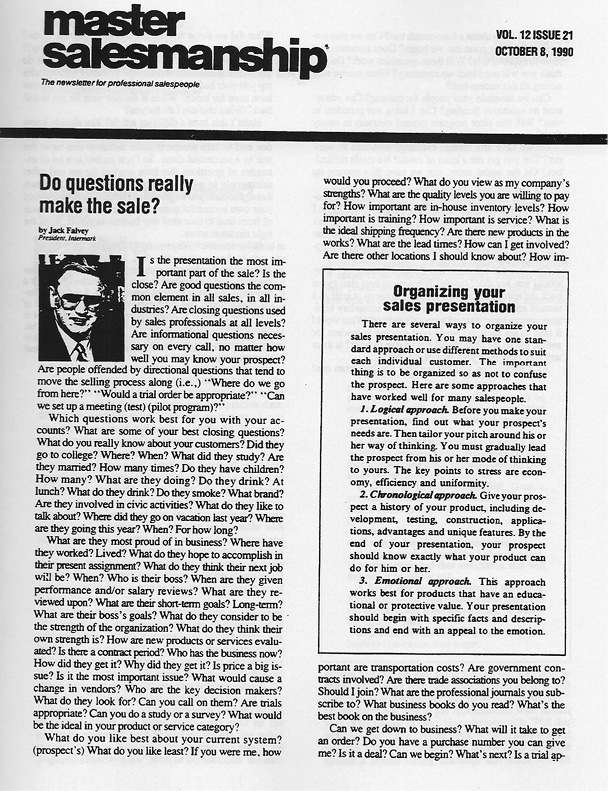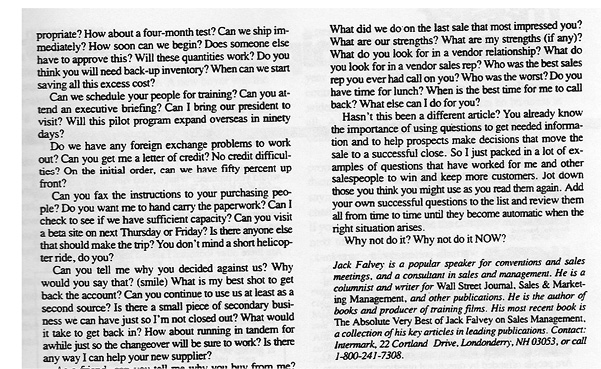Appendix 1
Sample Benchmarking Study Outline: Syndicated Market Research Company
- Study overview and design
- Familiarity with Syndicated Report Providers
- Reports Relied Upon Most
- Main Competitors
- Ratings of Company and Main Competitors
- Advantages and Disadvantages of Company
- Advantages and Disadvantages of Competitors
- Strong Statements Describing Company Studied and its Products
- Strong Statements Describing Competition
- Process of Searching, Selecting and Purchasing Reports
- Estimates for Generating DR Information In-house
- Awareness and Use of Decision Resources Products and Services
- Communications about New Reports and Improvements. Awareness
- Recommendations to Improve Usage
- Purposes for Which DR Products are Used
- Job Support and Utility Provided by Decision Resources Products
- Needs Not Met By DR and its Products
- Needs and Concerns which DR could Address
- Ideas for Better Partnering with Companies
- Suggestions for Improvements
- Interest Level in Proposed New Services
Appendix 2
Sample Aviation Checklist*
Introduction
Aviation is very procedural. Every action you will undertake in the aircraft will have a checklist tied to it somewhere. Many of the checklists are simple and can be memorized, but this is not always a good practice. Memories can be faulty, and in aviation, a faulty memory can be a death sentence. Use your checklists.
Here is an example of a preflight checklist for a 1967 Cessna 150:
- Remove Control Locks and Tie down Ropes
- Master—On
- Flaps—Down
- Fuel Gauge—Check
- Master—Off
- Ignition (MAGS)—Off
- Throttle—Closed (Pulled Out)
- Mixture—Lean (Pulled Out)
- Sample Fuel (Check for Water and Sediment)—Left Wing
- Inspect Left Side of Fuselage for Damage
- Inspect Leading Edge of Horizontal and Vertical Stabilizer for Damage
- Inspect Skin on Tail Surfaces for Damage
- Check Stabilizers, Elevator, and Rudder for excessive travel
- Check that Hinge Bolts are fastened and Cotter Pins are in Place on Tail Surfaces
- Inspect Right Side of Fuselage for Damage
- Drain Fuel (Check for Water and Sediment)—Right Wing
- Check Flaps for excessive travel, bolts are fastened, and Control Rod is attached and is not bent
- Check Ailerons for excessive travel, hinges are attached and not Cracked, Cotter Pins are attached to hinge ends
- Remove all Ice Formation from Aileron
- Check that Lead Weights are attached to Aileron
- Shake Right Wing Up and Down—Check for tightness and unusual Sounds
- Check Wing Struts—Check for tightness and unusual sounds
- Inspect Right Wing for Damage—Check for Wrinkles
- Inspect Main Landing Gear for Damage
- Inspect Main Landing Gear Tire for proper inflation, cuts, condition of tread, or foreign objects (screws or nails in tire)
- Inspect Brake Pads for wear
- Inspect Brake Line for leaks
- Check that Wheel is fastened to Landing Gear (Cotter Pin is in Place)
- Check Oil Level (4½ Quarts Minimum to Six Quarts Maximum)
- Check Oil Breather for blockage
- Drain Fuel from Fuel Strainer
- Check Inside the Cowling (Nose of Aircraft) for loose Wiring, Oil Leaks, Fuel Leaks, All Engine Accessories are installed and installed correctly
- Check that Cowling is fastened correctly—All Screws are attached
- Check Propeller and Spinner—Check for Damage and Security
- Check Engine Baffle—Check for Damage and Security
- Check Engine Baffle Seals—Check for Damage and Security
- Check Engine Exhaust Pipes—Check for Damage and Security
- Check Carburetor Air Filter—Clean
- Inspect Nose Gear for Damage and Proper Inflation (two inch spread on Nose Strut)
- Inspect Nose Gear Shimmy Dampener for Damage
- Check that all Bolts and Nuts are attached to nose fork assembly
- Inspect Nose Gear Tire for proper inflation, cuts, condition of Tread, or foreign objects (screws or nails in tire)
- Check that Wheel is fastened to Nose Gear—Bolt and Nut Attached
- Check Condition of Steering Rod Boots
- Check Static Port for Damage and Obstructions
- Check Radio Cooling Vent for Damage and Obstructions
- Check Pitot Tube for Damage and Obstructions
- Check Fuel Overflow Tube for Damage and Obstructions
- Check Stall Warning Port for Damage and Obstructions
- Check Wing Struts—Check for tightness and unusual sounds
- Inspect Left Wing for Damage—Check for Wrinkles
- Shake Left Wing Up and Down—Check for tightness and unusual sounds
- Check Ailerons for excessive travel, hinges are attached and not cracked, Cotter Pins are attached to hinge ends, Control Rod attached
- Remove All Ice Formation from Aileron
- Check that Lead Weights are attached to Aileron
- Check Flaps for excessive travel, bolts are fastened, and Control Rod is attached and is not bent
- Inspect Main Landing Gear for Damage
- Inspect Main Landing Gear Tire for Proper inflation, cuts, condition of tread, or foreign objects (screws or nails in tire)
- Inspect Brake Pads for wear
- Inspect Brake Line for leaks
- Check that Wheel is fastened to Landing Gear (Cotter Pin is in place)
- Check Left Fuel Tank
- Check Right Fuel Tank
- Check Top of Wings for Damage
- Remove all Ice Formation from the Top and Bottom of All Surfaces
- Check Navigation Lights, Landing Lights, Strobe Lights, Pulse Light System, and the Beacon for Damage and Proper Illumination
- Check Antennas for Damage
- Remove all Debris under Propeller (rocks etc.)
- Fold up Step Ladder and put it in the bed of the truck
Appendix 3
Operationally excellent firms maintain a strong competitive advantage by maintaining exceptional efficiency, thus enabling the firm to provide reliable service to the customer at a significantly lower cost than those of less well-organized and well-run competitors. The emphasis here is mostly on low cost, subject to reliable performance, and less value is put on customizing the offering for the specific customer. Wal-Mart is an example of this discipline. Elaborate logistical designs allow goods to be moved at the lowest cost, with extensive systems predicting when specific quantities of supplies will be needed.
Customer intimate firms excel in serving the specific needs of the individual customer well. There is less emphasis on efficiency, which is sacrificed for providing more precisely what is wanted by the customer. Reliability is also stressed. Nordstrom’s and IBM are examples of this discipline.
Technologically excellent firms, which produce the most advanced products currently available with the latest technology, constantly maintaining leadership in innovation. These firms, because they work with costly technology that need constant refinement, cannot be as efficient as the operationally excellent firms and also cannot often adapt their products to the needs of the individual customer. Intel is an example of this discipline (Hogan and Lucke 2004; Treacy and Wiersema 1993).
Appendix 4
Be Your Own Brand
We all have a brand, whether we like it or know it. A personal brand is simply a message, a thought. It is what other people think of when they think of you. It is the sum total of what people know about you. Every time you interact with another person, you are influencing your brand. What is your brand? Do you talk about big ideas? Are you clear and concise? Are you interesting? Do people pay attention to you?
People have a feeling about others as soon as they meet them. They continue to shape that feeling with subsequent interactions. When another person sees you, they register a positive, neutral or negative feeling. It is in your power to influence that feeling and make it positive every time.
A powerful person’s brand
•Is instantly recognizable
•Stands for something of value
•Builds trust
•Generates positive word of mouth
•Gives a competitive advantage
•Creates career opportunity
•Results in professional and financial success
Many people have the tools to create a strong personal brand. How do you create a buzz about yourself? One way is to start speaking in formal and informal settings. Speaking inside and outside your company positions you as an expert for several reasons:
•Many of your colleagues or competitors don’t do it.
•People assume that if you are speaking on a topic you are an expert.
•Other people promote your talk.
•You are center stage, which automatically gives you credibility.
•If you give a valuable talk, then people remember you.
•If they remember you, then you become top of mind and you are the one they think of when they refer someone for new business, promotions, other speaking engagements, and so on.
Wherever you are in your career, you can start sending strong, positive signals that will create buzz for you. You have the power, and need, to create your own personal brand. If not you, then who? If not now, then when? The more people you help through work and by sharing your insights, the more value you bring to others. This can create a virtuous cycle of you giving and receiving value to more and more people (Bates 2006, 27).
Appendix 5


